Doris (3×4)
The Doris (ドリス)[1] is a Japanese 3×4 folding camera, distributed from 1939 to 1941 by Fukada Shōkai.[2]
Contents
General description
The Doris is a strut-folder: the lens and shutter assembly is mounted on a square metal plate, supported by scissor struts placed on both sides. There is a tubular viewfinder above the middle of the top plate. There is a button on the right of the viewfinder; it looks like a shutter release but actually releases the lens board which pops out into shooting position. The back is hinged to the right and opened by a sliding button on the left. It contains two red windows, protected by a pivoting common cover.
Minor variations are known, notably in the position of the advance knob; these are discussed in the next sections. All the versions have a front-cell focusing lens and an everset shutter.
 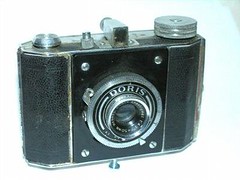
|
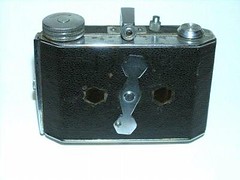 
|
| Doris (3×4), Doris Anastigmat 50mm f/4.5 lens, Doris shutter, advance knob on the left. Pictures courtesy of eBayer shoppingcartz. (Image rights) |
Commercial life
The Doris was advertised in Japanese magazines from August 1939.[3] The October 1939 advertisement in Asahi Camera says that the camera is a new model and lists three versions priced at ¥43, ¥48 and ¥58, but there is no description and no picture.[4] According to later documents, these versions correspond to the following lens and shutter combinations, in increasing price order:[5]
- Doris Anastigmat 50/4.5 lens, Doris shutter (25, 50, 100, T, B);
- U.L.L. Anastigmat 50/4.5 lens, Kerio shutter (25, 50, 100, 150, T, B);
- U.L.L. Anastigmat 50/4.5 lens, Selon II shutter (5, 10, 25, 100, 250, T, B).
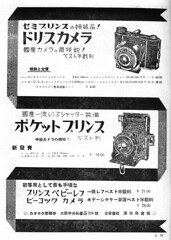
|
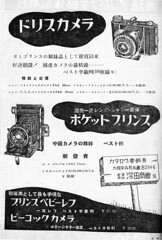
|
| April 1940 | May 1940 |
| Advertisements in Asahi Camera. (Image rights) | |
In Asahi Camera February 1940, the camera is reportedly advertised with the U.L.L. and Kerio combination.[3] Advertisements in the April and May 1940 issues of the same magazine, reproduced above, only list the other two versions: Doris / Doris at ¥43 and U.L.L. / Selon II at ¥58.[6] The case is offered for extra ¥6. The illustration shows a camera with the advance knob at the top right, as seen by the photographer, a small lens board release at the top, and a Selon shutter, marked SELON at the top of the front plate.
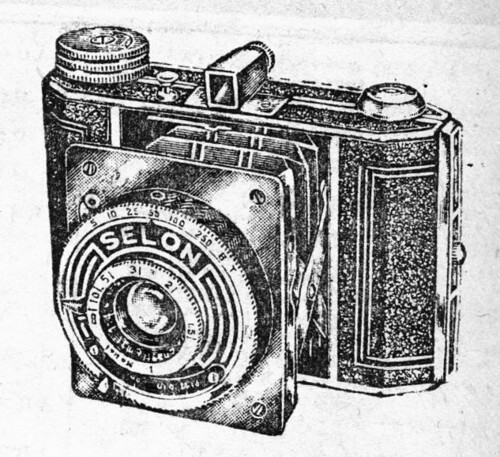
|
| Doris (3×4), Selon shutter, advance knob on the right. (Image rights) |
The Doris is also featured in the new products column of the May 1940 issue, reproduced below.[7] The long delay between the initial advertisement in August 1939 and this news announcement is unexplained. The document gives a description of the camera, and lists the three versions already mentioned.

|
| Column on the Doris in Asahi Camera May 1940. (Image rights) |
In the August 1940 advertisement in Asahi Camera, the range is as follows, with a new f/3.5 option at the top and no Kerio version:[8]
- Doris Anastigmat 50/4.5 lens, Doris shutter (25, 50, 100, T, B), ¥43;
- U.L.L. Anastigmat 50/4.5 lens, Selon[9] shutter (5, 10, 25, 100, 250, T, B), ¥58.
- U.L.L. Anastigmat 50/3.5 lens, same shutter (¥68).
The official list of set prices compiled in October 1940 and published in January 1941 has various Doris models, called "Doris I" (¥44), "Doris II" (¥60), "Doris III" (¥50) and "Doris IV" (¥68) with no further detail.[10] These certainly correspond to the four lens and shutter combinations described above.
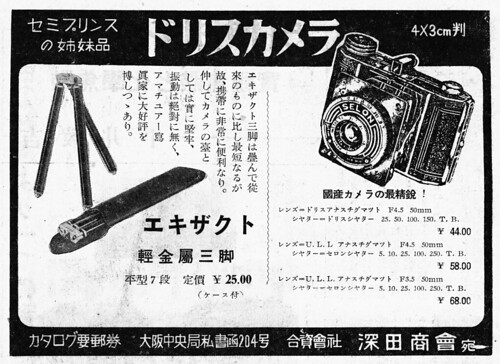
|
| Advertisement in Asahi Camera April 1941. (Image rights) |
The advertisement in Asahi Camera April 1941, reproduced above, lists the same versions as in August 1940, but the Doris shutter now has an additional 1/150 speed setting, and the price for that version was raised to ¥44.[11]
The Doris was advertised in Japanese photography magazines until May 1941.[3] Its successor was the Baby Doris, a 3×4cm vertical folder also distributed by Fukada Shōkai.
Actual examples
Only a few actual examples of the Doris have been observed so far. All have the advance knob at the top left, the reverse of the advertising illustration.
At least three cameras are known with the Doris Anastigmat 50mm f/4.5 lens and Doris shutter to 1/150.[12] The name DORIS is inscribed at the top of the shutter plate, and the speed settings are actually engraved in the order 150, 100, 50, 25, B, T.
These three examples show minor variations. The camera pictured in Sugiyama is presumably earlier, with a chrome-finished lens board and a small button at the top, similar to that visible in the advertisements. The example pictured in this page has a black lens board with a larger release button. The example this page pictured in the AJCC website is probably later. It has the large release button, black crinkle paint on the lens board, a different advance knob with two rows of mills, and a slightly lower film flange at the other end.
A further camera has been observed with a Kerio shutter (T, B, 150–25), marked KERIO at the top of the front plate, and a Ukas Anastigmat 50mm f/3.5 lens.[13] However, the diaphragm scale on that particular camera runs from 4.5 to 18, and it is likely that the Ukas lens is not original.
Manufacturer
The manufacturer of the Doris is not known for sure. In the advertisements observed, the camera is presented as a "sister of the Semi Prince" ("セミプリンスの姉妹品"), but it is not explicitly attributed to any specific company.
Some sources attribute the camera to "Prince Camera Works",[14] but this was not the name of any actual company, only a dummy name used for promotional purpose (see Camera Works). Moreover, this name is not associated to the Doris in any of the original documents seen so far.
The "Doris" name might be related to the name of Mr. Motodori, founder of the Motodori company. At least this was the case for the postwar Doris cameras made by Tōkyō Seiki and later Doris Camera (successors of the Motodori company).[15]
The April 1943 government inquiry on Japanese camera production mentions a Doris camera made by Shinkō, certainly corresponding to the later Baby Doris.[16] On that camera, the shape of the main body is similar to that of the original strut-folding Doris, and this perhaps indicates that the two models were made by the same manufacturer.
Notes
- ↑ The camera is called "Baby Doris (horizontal)" or "Baby Doris (horizontal format)" in Sugiyama, item 1038, and McKeown, p.803, but the name used in the original documents is "Doris" or "Doris Camera".
- ↑ Dates: advertisements and articles listed in Kokusan kamera no rekishi, p.338.
- ↑ 3.0 3.1 3.2 Kokusan kamera no rekishi, p.338.
- ↑ Advertisement reproduced in Kokusan kamera no rekishi, p.91.
- ↑ Column in Asahi Camera May 1940, pp.831–2.
- ↑ Advertisements in Asahi Camera April 1940, p.A56, and May 1940, p.A29. That dated April is reproduced in Kokusan kamera no rekishi, p.80.
- ↑ Column in Asahi Camera May 1940, pp.831–2.
- ↑ Advertisement reproduced in Kokusan kamera no rekishi, p.80.
- ↑ The shutter name is given as "Selon shutter" (セロンシヤター), with no mention of model II.
- ↑ "Kokusan shashinki no kōtei kakaku", compiled on October 25, 1940 and published in January 1941, type 1, sections 4A, 5, 6A, 8A.
- ↑ Advertisement in Asahi Camera April 1941, p.633.
- ↑ Examples pictured in this page, in Sugiyama, item 1038, in this page of the AJCC.
- ↑ Example observed in an online auction, with Ukas lens no.51104.
- ↑ Sugiyama, item 1038; McKeown, p.803.
- ↑ Niimi, p. 92.
- ↑ "Kokusan shashinki no genjōchōsa" ("Inquiry into Japanese cameras"), items 170–1.
Bibliography
Original documents
- Asahi Camera May 1940. "Atarashii kikai to zairyō" (新しい機械と材料, New equipment and machinery). Pp.831–2.
- Asahi Camera. Advertisements by Fukada Shōkai:
- April 1940, p.A56;
- May 1940, p.A29;
- April 1941, p.633.
- "Kokusan shashinki no kōtei kakaku" (国産写真機の公定価格, Set prices of the Japanese cameras), listing Japanese camera production as of October 25, 1940 and setting the retail prices from December 10, 1940. Published in Asahi Camera January 1941 and reproduced in Shōwa 10—40nen kōkoku ni miru kokusan kamera no rekishi (昭和10〜40年広告にみる国産カメラの歴史, Japanese camera history as seen in advertisements, 1935—1965). Tokyo: Asahi Shinbunsha, 1994. ISBN 4-02-330312-7. Pp.108—9. Type 1, sections 4A, 5, 6A and 8A.
Recent sources
- Asahi Camera (アサヒカメラ) editorial staff. Shōwa 10–40nen kōkoku ni miru kokusan kamera no rekishi (昭和10–40年広告にみる国産カメラの歴史, Japanese camera history as seen in advertisements, 1935–1965). Tokyo: Asahi Shinbunsha, 1994. ISBN 4-02-330312-7. Item 155. (See also the advertisement for items 230–1.)
- McKeown, James M. and Joan C. McKeown's Price Guide to Antique and Classic Cameras, 12th Edition, 2005-2006. USA, Centennial Photo Service, 2004. ISBN 0-931838-40-1 (hardcover). ISBN 0-931838-41-X (softcover). P.803.
- Niimi Kahee (新見嘉兵衛). Kamera-mei no gogen sanpo (カメラ名の語源散歩, Strolls in the etymology of camera names). 2nd ed. Tokyo: Shashin Kōgyō Shuppansha, 2002. ISBN 4-87956-060-X
- Sugiyama, Kōichi (杉山浩一); Naoi, Hiroaki (直井浩明); Bullock, John R. The Collector's Guide to Japanese Cameras. 国産カメラ図鑑 (Kokusan kamera zukan). Tokyo: Asahi Sonorama, 1985. ISBN 4-257-03187-5. Item 1038.